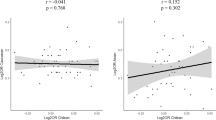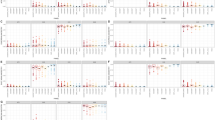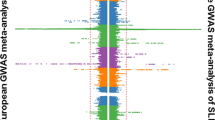Abstract
Systemic Lupus Erythematosus (SLE) disproportionately affects minorities, such as Hispanic Americans (HA). Prevalence of SLE is 3–5 times higher in HA than in European-derived populations and have more active disease at the time of diagnosis, with more serious organ system involvement. HA is an admixed population, it is possible that there is an effect of admixture on the relative risk of the disease. This admixture can create substantial increase of linkage disequilibrium (LD) in both magnitude and range, which can provide a unique opportunity for admixture mapping. The main objectives of this study are to (a) estimate hidden population structure in HA individuals; (b) estimate individual ancestry proportions and its impact on SLE risk; (c) assess impact of admixture on ITGAM association, a recently identified SLE susceptibility gene; and (d) estimate power of admixture mapping in HA. Our dataset contained 1125 individuals, of whom 884 (657 SLE cases and 227 controls) were self-classified as HA. Using 107 unlinked ancestry informative markers (AIMs), we estimated hidden population structure and individual ancestry in HA. Out of 5671 possible pairwise LD, 54% were statistically significant, indicating recent population admixture. The best-fitted model for HA was a four-population model with average ancestry of European (48%), American-Indian (AI) (40%), African (8%) and a fourth population (4%) with unknown ancestry. We also identified significant higher risk associated with AI ancestry (odds ratio (OR)=4.84, P=0.0001, 95% CI (confidence interval)=2.14–10.95) on overall SLE. We showed that ITGAM is associated as a risk factor for SLE (OR=2.06, P=8.74 × 10−5, 95% CI=1.44–2.97). This association is not affected by population substructure or admixture. We have shown that HA have great potential and are an appropriate population for admixture mapping. As expected, the case-only design is more powerful than case–control design, for any given admixture proportion or ancestry risk ratio.
This is a preview of subscription content, access via your institution
Access options
Subscribe to this journal
Receive 6 digital issues and online access to articles
$119.00 per year
only $19.83 per issue
Buy this article
- Purchase on Springer Link
- Instant access to full article PDF
Prices may be subject to local taxes which are calculated during checkout



Similar content being viewed by others
References
Alarcon GS, McGin Jr G, Petri M, Reveille JD, Ramsey-Goldman R, Kimberly RP, for the PROFILE Study Group. Baseline characteristics of a multiethnic lupus cohort: PROFILE. Lupus 2002; 11: 95–101.
McKeigue PM . Prospects for admixture mapping of complex traits. Am J Hum Genet 2005; 76: 1–7.
Smith MW, O'Brien SJ . Mapping by admixture linkage disequilibrium: advances, limitations and guidelines. Nature Rev Genet 2005; 6: 623–632.
Chakraborty R, Weiss KM . Frequencies of complex diseases in hybrid populations. Am J Phys Anthropol 1986; 70: 489–503.
Escalante A, Rincon ID . Epidemiology and impact on rheumatic disorders in the US Hispanic population. Curr Opin Rheumatol 2001; 13: 104–110.
Reveille JD, Moulds JM, Ahn C, Friedman AW, Baethge B, Roseman J et al. Systemic Lupus Erythematosus in three ethnic groups. I. The effects of HLA Class II, C4, and CR1 alleles, socioeconomic factors, and ethnicity at disease onset. Arthritis Rheum 1998; 41: 1161–1172.
Molina JF, Molina J, Garcia G, Gharavi AE, Wilson WA, Espinoza LR . Ethnic differences in the clinical expression of Systemic Lupus Erythematosus: a comparative study between African-Americans and Latin Americans. Lupus 1997; 6: 63–67.
Petri M, Perez-Gutthann S, Longenecker JC, Hochberg M . Morbidity of Systemic Lupus Erythematosus: role of race and socioeconomic status. Am J Med 1991; 91: 345–353.
Patterson N, Hattangadi N, Lane B, Lohmueller KE, Hafler DA, Oksenberg JR et al. Methods for high-density admixture mapping of disease genes. Am J Hum Genet 2004; 74: 979–1000.
The International HapMap Consortium. The International HapMap Project. Nature 2003; 426: 789–796.
Jakobsson M, Scholz SW, Scheet P, Gibbs JR, VanLiere JM, Fung H-C et al. Genotype, haplotype and copy-number variation in worldwide human populations. Nature 2008; 451: 998–1003.
Weir BS, Cockerham CC . Estimating F-statistics for the analysis of population structure. Evolution 1984; 38: 1358–1370.
Nei M . Molecular Evolutionary Genetics. Columbia University Press: New York, 1987.
Seldin MF, Qi L, Scherbarth HR, Tian C, Ransom M, Silva G et al. Amerindian ancestry in Argentina is associated with increased risk for Systemic Lupus Erythematosus. Genes Immun 2008; 9: 389–393.
Nath SK, Han S, Kim-Howard X, Kelly JA, Viswanathan P, Gilkeson GS et al. A nonsynonymous functional variant in integrin-alpha(M) (encoded by ITGAM) is associated with systemic lupus erythematosus. Nat Genet 2008; 40: 152–154.
Hoggart CJ, Shriver MD, Kittles RA, Clayton DG, McKeigue PM . Design and analysis of admixture mapping studies. Am J Hum Genet 2004; 74: 965–978.
Montana G, Pritchard JK . Statistical tests for admixture mapping with case–control and cases-only data. Am J Hum Genet 2004; 75: 771–789.
Sans M . Admixture Studies in Latin America: from the 20th to the 21th century. Hum Biol 2000; 72: 155–177.
Yang N, Li H, Criswell LA, Gregersen PK, Alarcon-Riquelme ME, Kittles R et al. Examination of ancestry and ethnic affiliation using highly informative diallelic DNA markers: application to diverse and admixed populations and implications for clinical epidemiology and forensic medicine. Hum Genet 2005; 118: 382–392.
Tian C, Hinds DA, Shigeta R, Adler SG, Lee A, Pahl MV et al. A genomewide single-nucleotide plymorphism panel for Mexican American admixture mapping. Am J Hum Genet 2007; 80: 1014–1023.
Kao WH, Klag MJ, Meoni LA, Reich D, Berthier-Shaad Y, Man L et al. MYH9 is associated with nondiabetic end-stage renal disease in African Americans. Nat Gen 2008; 40: 1185–1192.
Haiman CA, Patterson N, Freedman ML, Myers SR, Pike MC, Waliszewska A et al. Multiple regions within 8q24 independently affect risk for prostate cancer. Nat Gen 2007; 39: 638–644.
Price AL, Patterson N, Yu F, Cox DR, Waliszewska A, McDonald GJ et al. A genomewide admixture map for Latino populations. Am J Hum Genet 2007; 80: 1024–1036.
Mao X, Bigham AW, Mei R, Gutierrez G, Weiss KM, Brutsaert TD et al. A Genomewide admixture mapping panel for Hispanic/Latino populations. Am J Hum Genet 2007; 80: 1171–1178.
Tan EM, Cohen AS, Fries JF, Masi AT, McShane DJ, Rothfield NF et al. The 1982 revised criteria for the classification of Systemic Lupus Erythematosus. Arthritis Rheum 1982; 25: 1271–1277.
Hochberg MC . Updating the American College of Rheumatology revised criteria for the classification of systemic lupus erythematosus. Arthritis Rheum 1997; 40: 1725–1734.
Harley JB, Alarcón-Riquelme ME, Criswell LA, Jacob CO, Kimberly RP, Moser KL et al. Genome-wide association scan in women with systemic lupus erythematosus identifies susceptibility variants in ITGAM, PXK, KIAA1542 and other loci. International Consortium for Systemic Lupus Erythematosus Genetics (SLEGEN). Nat Genet 2008; 40: 204–210.
Purcell S, Neale B, Todd-Brown K, Thomas L, Ferreira MAR, Bender D et al. PLINK: a toolset for whole-genome association and population-based linkage analysis. Am J Hum Genet 2007; 81: 559–575.
Goudet J . FSTAT (Version 1.2): a computer program to calculate F-statistics. J Hered 1995; 86: 485–486.
Gabriel SB, Schaffner SF, Nguyen H, Moore JM, Roy J, Blumenstiel B et al. Structure of Haplotype blocks in the human genome. Science 2002; 296: 2225–2229.
Reich DE, Cargill M, Bolk S, Ireland J, Sabeti PC, Richter DJ et al. Linkage disequilibrium in the human genome. Nature 2001; 411: 199–204.
Choudhry S, Coyle NE, Tang H, Salari K, Lind D, Clark SL et al. Population stratification confounds genetic association of studies among Latinos. Hum Genet 2006; 118: 652–664.
Pritchard J, Stephens M, Rosenberg NA, Donnelly P . Association mapping in structured populations. Am J Hum Genet 2000; 67: 170–181.
Falush D, Stephens M, Pritchard JK . Inference of population structure using multilocus genotype data: linked loci and correlated allele frequencies. Genetics 2003; 164: 1567–1587.
Pritchard J, Stephens M, Donelly P . Inference of population structure using multilocus genotype data. Genetics 2000; 155: 945–959.
Aulchenko YS, Ripke S, Isaacs A, van Duijn CM . GenABEL: an R library for genome-wide association analysis. Bioinformatics 2007; 23: 1294–1296.
Evanno G, Regnaut S, Goudet J . Detecting the number of clusters of individuals using the software STRUCTURE: a simulation study. Mol Ecol 2005; 14: 2611–2620.
SAS [Computer program]. Version 9.1. SAS InstituteCary, NC, 2008.
Review Manager (RevMan) [Computer program]. Version 5.0. The Nordic Cochrane Centre, The Cochrane Collaboration: Copenhagen, 2008.
Acknowledgements
We wish to thank the patients and their families for their cooperation and blood samples. We also like to acknowledge the support from LFRR staffs, especially, Gail Bruner, Jennifer Kelly, Dr Jashua Ojwang, Dr Ken Kaufman for conducting a large-scale genotyping project from which the current samples were genotyped. In addition, we would like to thank Dr Judith James and Dr Gary Gilkerson for providing genotypic data on some Hispanic samples used in this study. This study was made possible by funding from AR42460, AR12253, AR48940, Alliance for Lupus Research, RO1A1063622, PO1AR049084, P30AR053483 and P20RR020143.
Author information
Authors and Affiliations
Corresponding author
Rights and permissions
About this article
Cite this article
Molineros, J., Kim-Howard, X., Deshmukh, H. et al. Admixture in Hispanic Americans: its impact on ITGAM association and implications for admixture mapping in SLE. Genes Immun 10, 539–545 (2009). https://doi.org/10.1038/gene.2009.30
Received:
Revised:
Accepted:
Published:
Issue Date:
DOI: https://doi.org/10.1038/gene.2009.30



